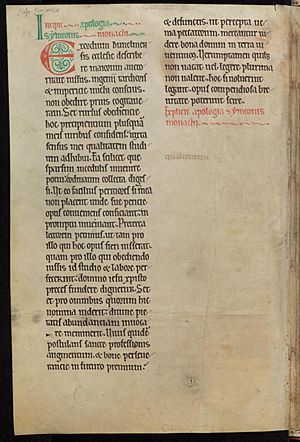Libellus de exordio facts for kids
The Libellus de exordio atque procursu istius, hoc est Dunhelmensis, ecclesie is a very long name for a book! It means Tract on the Origins and Progress of this the Church of Durham. Most people just call it the Libellus de exordio, or sometimes the Historia Dunelmensis ecclesiae (which means History of the Church of Durham).
This book is an important history text from the early 12th century. It tells the story of the church in Durham, England. It also covers the history of earlier churches in places like Lindisfarne and Chester-le-Street. People usually believe that a monk named Symeon of Durham wrote or put together this book.
Contents
Copies of the Book: Manuscripts
Many copies of the Libellus de exordio exist. These old, handwritten copies are called manuscripts. Each manuscript is unique. They might have different notes or small changes made over time.
Here are some of the main manuscripts:
- Durham, University Library, Cosin V.II.6
- London, British Library, Cotton Faustina A.V
- Cambridge University Library, Ff. i.27
- Durham, Durham Cathedral Library, A.IV.36
- Oxford, Bodleian Library, Holkham misc. 25
- London, British Library, Cotton Titus A.II
- London, British Library, Cotton Vespasian A.VI
- York, Minster Library, XVI.I.12
- Oxford, Bodleian Library, Fairfax 6
- Oxford, Bodleian Library, Laud misc. 700
Who Wrote It and When?
The Libellus starts by saying that the leaders of the Durham Priory asked for this book to be written. It was probably Prior Turgot, a high-ranking monk, who ordered it.
The latest event mentioned in the book is when the tomb of St Cuthbert was opened. This happened on August 29, 1104. This was done to move his body to the new Durham Cathedral. The oldest copies of the book were made while Turgot was still the prior. He left his position by 1115, or maybe even earlier, by 1107. This means the book was likely finished sometime between 1104 and 1115.
Most people believe Symeon of Durham wrote the book. He was a precentor (a monk who leads the singing) at Durham Cathedral. We know this because some later copies of the book have notes, called rubrics, that say he wrote it. Even though the very oldest copies don't say this, experts today still agree that Symeon was the main author. He probably gathered information and put it all together.
Published Versions of the Book
The Libellus de exordio has been printed as a book four times:
- In 1652, by Roger Twysden.
- In 1732, by Thomas Belford.
- In 1882-1885, by Thomas Arnold.
- In 2000, by David Rollason.
The most recent version by David Rollason is very helpful. It includes the original Latin text on one page and an English translation right next to it. This makes it much easier for people to read and understand the old history.
What the Book is About
The Libellus de exordio covers a long period of history. It starts with the beginning of Christianity in Northumbria, a kingdom in old England. It talks about the first church leaders, called bishops, in Lindisfarne. The book ends with the death of Bishop William of Saint-Calais in 1096.
The book shows how the history of Durham's church continued over many years. It also explains why Bishop William of Saint-Calais removed the old church community in Durham in 1083. He replaced them with a group of Benedictine monks.
A very important part of the book is the story of Saint Cuthbert. He was a holy person and the church's special protector. The book describes many amazing things that happened because of Saint Cuthbert. For example:
- The miracle of the three waves: Saint Cuthbert made part of the sea turn into blood. This stopped his followers from taking his holy items out of England.
- The foundation of Durham: When Saint Cuthbert's body was being moved, his cart suddenly stopped and wouldn't move. This was seen as a sign that he wanted to stay in Durham.
- The book also tells stories of bad things happening to people who were enemies of Saint Cuthbert's followers.
The Libellus is divided into four main parts, called books:
- Book I: Covers the time from King Oswald of Northumbria (634-642) to King Ceolwulf of Northumbria (729-737).
- Book II: Continues from King Ceolwulf's death (737) to Bishop Ealdhun (995).
- Book III: Goes from Bishop Ealdhun (995) to the murder of Bishop Walcher (1080).
- Book IV: Focuses on Bishop William of Saint-Calais and the new start of the Priory (1081-1096).
The author used many older writings to create this book. These included works by a famous historian named Bede. They also used some old Northumbrian writings that are now lost. The book even includes stories from the monks who were removed by Bishop William.
Later Additions to the Book
There are two other texts that continue the story of the Libellus de exordio.
- Some copies of the book include a short summary that ends around 1083. This was when the Benedictine monastery was started in Durham. It's not clear if this summary was written before or after the main Libellus book.
- Most copies of the Libellus also have an extra section. This part covers the time from Bishop Ranulf Flambard (1099-1128) to Bishop William de St Barbe (1143-1152). One copy even goes further, ending with Bishop Hugh le Puiset (1153-1195).


